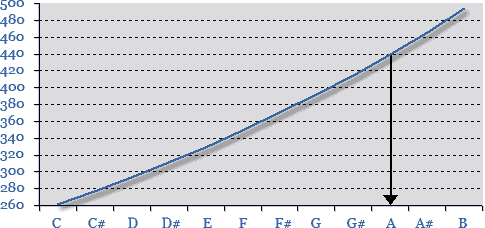The pitch as a hertz value
The following table contains the different octave ranges and the hertz values of the tones in each octave. The first column on the left is the (imaginary) infraoctave and well outside the hearing range: its frequencies cannot be perceived as auditory sensations but as physical vibrations with one's sense of touch. The frequency of this C3 is approximately 8 Hz, or eight beats per second, which corresponds rhythmically with sixteenth tones, when the tempo of the quarter stroke is approximately 123 bps (beats per minute). The ultraoctave on the right also extends beyond the hearing range.
The actual hearing range starts with the second column. The frequencies of the 1st octave are given with additional precision. The official frequency of the one-lined A is 440 Hz, although current practice favours frequencies of 442443 Hz or even 446 Hz. The hertz value can be calculated using the following formula:

i is the ratio used for multiplying the original hertz value, while c is the cent value of the interval.
For calculating the frequency of a 1st octave B, when A is 443 Hz, the formula becomes: 443 · 10(200 · log2/1200)
The difference between A and B is 200 cents. The result is 497.25 Hz.
The frequency of the 1st octave C (c = -900) can be calculated using the same formula. The result is 263.4 Hz.
The bottom line of the following table includes the American notation for octave ranges. It is commonly used in applications such as MIDI technology, where g becomes G3 and e2 becomes E5.
| sub- contra |
contra | great | small | one-lined | 2-lined | 3-lined | 4-lined | 5-lined | 6-lined | 7-lined | ||
| C | 8,18 | 16,35 | 32,70 | 65,41 | 130,8 | 261,6 | 523,3 | 1047 | 2093 | 4186 | 8372 | 16744 |
| C# | 8,66 | 17,32 | 34,65 | 69,30 | 138,6 | 277,2 | 554,4 | 1109 | 2217 | 4435 | 8870 | 17740 |
| D | 9,18 | 18,35 | 36,71 | 73,42 | 146,8 | 293,7 | 587,3 | 1175 | 2349 | 4699 | 9397 | 18795 |
| D# | 9,72 | 19,45 | 38,89 | 77,78 | 155,6 | 311,1 | 622,3 | 1245 | 2489 | 4978 | 9956 | 19912 |
| E | 10,30 | 20,60 | 41,20 | 82,41 | 164,8 | 329,6 | 659,3 | 1319 | 2637 | 5274 | 10548 | 21096 |
| F | 10,91 | 21,83 | 43,65 | 87,31 | 174,6 | 349,2 | 698,5 | 1397 | 2794 | 5588 | 11175 | 22351 |
| F# | 11,56 | 23,12 | 46,25 | 92,50 | 185,0 | 370,0 | 740,0 | 1480 | 2960 | 5920 | 11840 | 23680 |
| G | 12,25 | 24,50 | 49,00 | 98,00 | 196,0 | 392,0 | 784,0 | 1568 | 3136 | 6272 | 12544 | 25088 |
| G# | 12,98 | 25,96 | 51,91 | 103,8 | 207,7 | 415,3 | 830,6 | 1661 | 3322 | 6645 | 13290 | 26580 |
| A | 13,75 | 27,50 | 55,00 | 110,0 | 220,0 | 440,0 | 880,0 | 1760 | 3520 | 7040 | 14080 | 28160 |
| A# | 14,57 | 29,14 | 58,27 | 116,5 | 233,1 | 466,2 | 932,3 | 1865 | 3729 | 7459 | 14917 | 29834 |
| H | 15,43 | 30,87 | 61,74 | 123,5 | 246,9 | 493,9 | 987,8 | 1976 | 3951 | 7902 | 15804 | 31609 |
| C-1 | C0 | C1 | C2 | C3 | C4 | C5 | C6 | C7 | C8 | C9 | C10 |
The table below can be used for examining the approximate proportions of frequencies and pitches. The diagram only expresses frequencies within the range of the 1st octave. The chart illustrates how, for example, a pitch with a frequency of 320 Hz is located between the 1st octave D sharp and E. The frequencies of 160, 80, 40 and 20 Hz are, correspondingly, between the same pitch names in the lower octave ranges.
Tone frequencies (Hz)


